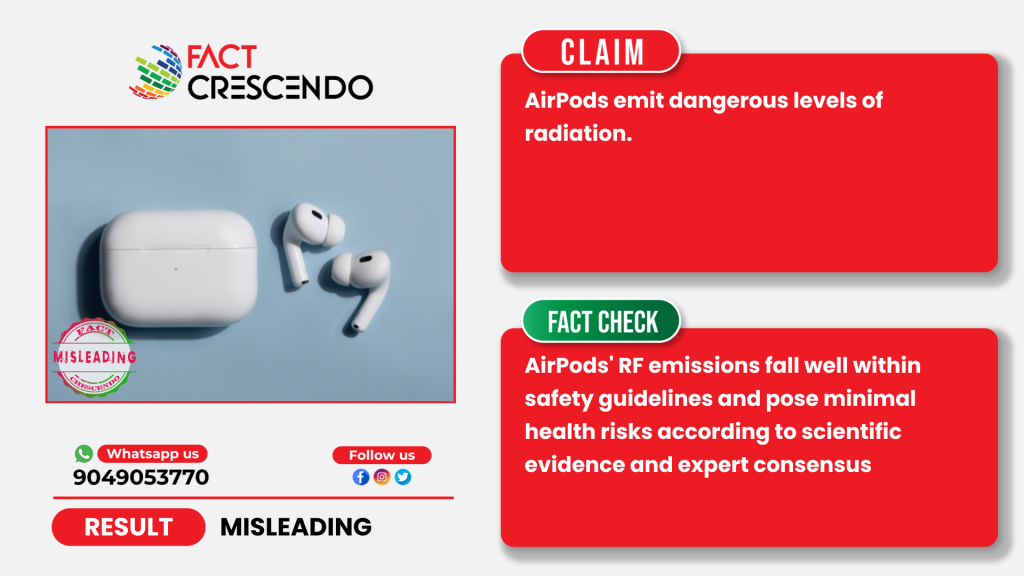
In recent years, concerns about electromagnetic fields (EMF) and their potential health impacts have surged, fueled by the widespread use of wireless devices like Apple AirPods. A specific claim circulating online asserts that AirPods emit a “shocking amount of radiation” when turned on and off. This claim has sparked debates about the safety of Bluetooth devices. But what does the science say?
Social Media Posts
We have found that the video showing AirPods being measured with an Electrosmog Meter, claiming they release radiation levels that are dangerous to human health, has been circulating on both Facebook and X platforms.
Fact-Check
What Is EMF Radiation, and Do AirPods Emit It?
AirPods use Bluetooth, which relies on low-energy radio waves, aka non-ionizing RF radiation, to connect to your devices. Unlike ionizing radiation (e.g., X-rays), non-ionizing RF radiation lacks the energy to damage DNA or cause cancer directly, as noted by the United States Environmental Protection Agency (EPA). EMF, or electromagnetic fields, are waves produced by electricity in general, from microwave ovens to computers, and have been part of daily life long before Bluetooth headphones existed.
While AirPods do emit RF radiation when active, and potentially minimal amounts when in pairing mode even when “off,” the levels are low and intermittent, typically measured in milliwatts (Source: Healthline).
Are These Emissions Safe?
The U.S. Federal Communications Commission (FCC) regulates RF exposure limits for consumer devices based on decades of research. These limits focus on preventing thermal effects—currently the only proven health risk from high-level RF exposure. The FCC sets a Specific Absorption Rate (SAR) limit of 1.6 watts per kilogram (W/kg) for devices like AirPods, while the European Union permits up to 2 W/kg.
Apple reports that AirPods operate well below these thresholds. Unlike mobile phones which typically have higher SAR values, Bluetooth devices like AirPods use Class 1 transmission power, emitting significantly less radiation. Most other Bluetooth devices use even lower-power Class 2 or 3 transmissions (Source: Headphonesty).
Apple’s FCC Report
Apple’s FCC report for AirPods (model BCG-A2084) verifies compliance with RF exposure limits. The technical document details SAR testing results, which are 0.072 W/kg for head and 0.603 W/kg for body measurements at specific frequencies and conditions. These measurements demonstrate that AirPods operate well within the FCC’s 1.6 W/kg limit. This report, while designed for regulatory compliance purposes, provides test results demonstrating that AirPods operate within FCC safety guidelines.
We have also contacted Apple for further clarification and will update this article once we receive their response.
Scientific Consensus and Expert Views
The International Commission on Non-Ionizing Radiation Protection (ICNIRP) informed Reuters that “no health problems should be expected” because “the latest evaluation of the scientific literature [shows] there is no scientific proof that EMFs cause cancer”.
On top of that, A spokesperson for Public Health England noted that “There is no convincing evidence that exposure to electromagnetic fields has adverse health effects provided exposures are below ICNRP guideline levels”.
Dr Joel Moskowitz, director of the Center for Family and Community Health at the University of California, Berkeley, who specializes in cell phone exposure, notes that research on potential brain effects is still lacking. While he doesn’t consider these devices completely unsafe, he warns that research and regulation of wireless technologies aren’t keeping pace with their adoption, a gap that could have significant health implications.
As concerns grow about potential links between Bluetooth devices and cancer risk, numerous studies have investigated this connection. While no evidence shows these devices cause cancer, a 2020 study by Shiwangi Gupta, Radhey Shyam Sharma & Rajeev Singh on non-ionizing radiation as a possible carcinogen highlights that “Though the usage of such radiation emitting from mobile phones has risen steeply, there is a lack of proper knowledge about the associated risks.”
How Does the Electrosmog Meter Work?
The claim centers on measurements from an Electrosmog Meter, which measures radio frequency (RF) signals. While this device can detect signals from AirPods and other wireless devices, merely detecting these signals doesn’t mean they’re harmful. The measurements need expert analysis to be meaningful, and the viral claim about “shocking” radiation levels doesn’t provide any actual numbers or compare them to safety standards.
The ED88TPlus5G model, as seen in the claiming video, detects electromagnetic fields across various frequencies—from power lines to wireless signals like Bluetooth and Wi-Fi. It displays these measurements in either voltage per meter (V/m) or power density (µW/m²).
While the device helps people find sources of electromagnetic fields in their environment, its readings can be misleading without proper context. For example, seeing a spike when AirPods turn on might seem alarming, but these levels are typically well within safe limits set by regulators. Understanding these measurements requires comparing them to established safety guidelines from organizations like the FCC or ICNIRP.
Summary
Based on the evidence examined, claims about AirPods emitting “shocking” radiation levels are misleading. While these devices do emit low-level RF radiation for Bluetooth connectivity, the emissions fall well within established safety guidelines set by regulatory bodies worldwide. Scientific consensus, supported by extensive research and expert opinions, indicates that AirPods and similar Bluetooth devices pose minimal health risks under normal use, though ongoing research continues to monitor potential long-term effects.

Title:AirPods Do Not Emit “Dangerous” Levels of Radiation
Fact Check By: Cielito WangResult: Misleading


